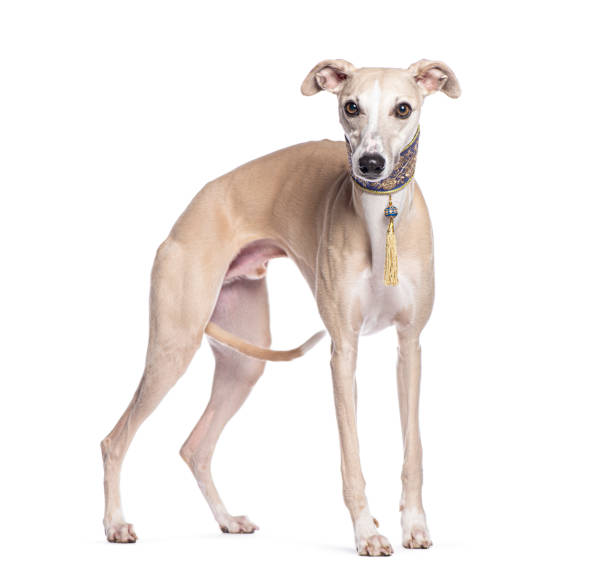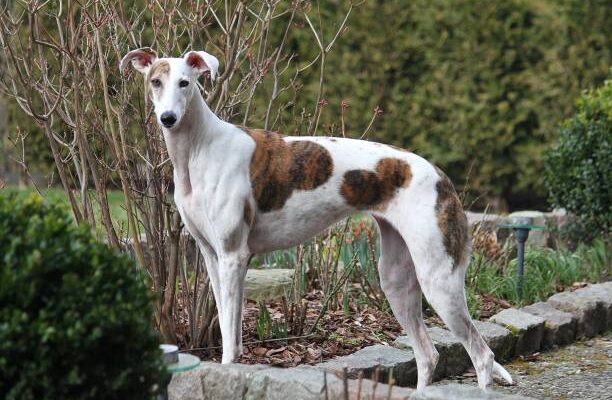Whippet possess a graceful profile along with their medium-sized body frame and their calm attitudes as well as their remarkable agility. When originally bred for racing and hunting events Whippet evolved into lovable pets because of their friendly nature, along with their basic care needs. The complete lifestyle of Whippet involves an analysis of their historical roots and physical features and their necessary movement patterns and care routines together with their social tendencies.
Table of Contents
- Introduction to Whippets
- History and Origin
- Physical Characteristics
- Personality and Temperament
- Training a Whippet
- Exercise and Activity Needs
- Nutritional Requirements and Diet
- Grooming and Hygiene
- Common Health Issues and Preventive Care
- Socialization and Behavior
- Living Conditions and Adaptability
- Fun Activities and Games
- Conclusion
Introduction to Whippets
The pace runner breed known as the Whippets belongs to the sighthound classification yet stands smaller than its cousin Greyhound. The Whippets earns its “miniature Greyhound” nickname because of its bodily shape yet requires special mention for its speed with added characteristics of elegance and quiet behavior. The Whippet breed establishes emotional bonds with their family while adapting to live comfortably in homes located either in cities or suburban areas.
Their sturdy athletic quality combined with their relaxed behavioral profile enables them to suit active individuals and peaceful household families. New dog owners consider Whippets appealing because they require minimal daily care.
History and Origin
Origins in England
Breeding of Whippets took place in Northern England during the period spanning from the 18th to 19th centuries. The working-class created the Whippet breed primarily for hunting rabbits and small game animals. People valued the breed because it had sharp vision while being fast at start-ups and highly motivated to chase prey.
Racing Heritage
Whippets gained popularity in racing competitions when owners organized rag racing events for their dogs to chase running cloth. Whippets obtained their “poor man’s racehorse” title because of their exceptional race abilities. Through recognition for its distinctive beauty alongside excellent athletic capabilities the Whippet assumed widespread popularity across sporting contests alongside show rings.
Recognition as a Breed
During the late 1800s the Kennel Club granted official recognition status to the breed in the UK. The American Kennel Club (AKC) introduced their registry during 1888. Activated in modern times as competitive athletes among other functions Whippets serve as calm domestic dogs for families.
Fun Fact:
The Whippet dog can accomplish speeds of 35 mph which ranks it among the highest-speed dog breeds in terms of its physical dimensions.
Physical Characteristics
Size and Build
- Height: 18–22 inches (at the shoulder)
- Weight: 25–40 pounds
- Build: Lean, muscular, and aerodynamic
Whippets possess an elegant, athletic build that is both functional and beautiful. Their streamlined bodies are designed for speed, while their long legs and narrow waist enhance agility.
Coat and Colors
The Whippet demonstrates a short smooth coat which accords closely to its bodily structure. This breed has a basic maintenance grooming routine because it features many adaptable color and pattern choices.
Common Coat Colors:
- Brindle
- Fawn
- Blue
- Black
- White
- Red
- Combinations with patches or markings
Due to their thin coat and low body fat, Whippets are sensitive to temperature extremes, particularly the cold.
Personality and Temperament
People usually consider this dog breed to be an affectionate companion with exceptional gentleness and adaptability. its appear distant to unfamiliar people yet stay fully bonded to their people and show extreme devotion.
Are Whippets Good Family Dogs?
Absolutely. Whippets make excellent pet choices for households of all types including individual adults together with retired individuals and those who have children. The dogs show positive behavior towards kind children and maintain peaceful relationships with fellow canine residents. As house pets Whippets show the best qualities because they remain calm and relaxed in every situation.
Are Whippets Good Guard Dogs?
Not quite. Whippet dogs avoid showing territorial behavior or aggression towards others. When faced with unknown noise sources Whippets typically move away instead of taking protective action. Their shy character together with their gentle personality proves more suitable for friendship than home protection.
Training a Whippet

Intelligence and Trainability
The combination of high intelligence and eager-to-please nature exists in Whippets along with occasional independent behavior. Training success with these dogs depends on using rewarding methods and maintaining stability in their education program.
Basic Training Tips:
Start early education about social interactions together with fundamental obedience classes
Particularly when training a Whippet select positive rewards along with verbal commendations to build good behaviors.
The use of harsh punishments should be avoided because it could lead to fear-induced anxiety in dogs.
Each training session should be short yet exciting to maintain attention.
Socialization
Socialization demonstrates its most important value for puppies before they reach adulthood. Socialization with various people and places together with sound exposure helps build confident temperament in Whippets because they tend to be both sensitive and reserved.
Exercise and Activity Needs
Whippets showcase their energetic nature mostly during physical activities yet show relaxed behavior inside their home territory.
Daily Exercise Needs
- Duration: 45–60 minutes per day
- Walks: At least two brisk walks
- Free Play: Off-leash running in a secure area when possible
Mental Stimulation
The Whippet breed requires mental challenges alongside regular interaction activities although they demand less mental work compared to working dog breeds.
Ideas for Mental Engagement:
- Scent-based games
- Interactive toys
- Short training sessions
- Hide-and-seek
Nutritional Requirements and Diet
Owners must offer dogs suitable dietary foods that consider their age group and physical size and exercise levels.
Recommended Diet
- Proteins: Chicken, fish, beef, or lamb
- Fats: Omega-3 and Omega-6 fatty acids for skin and coat health
- Carbohydrates: Whole grains, rice, and vegetables
- Supplements: Glucosamine and chondroitin (especially for active or aging dogs)
Feeding Schedule
- Puppies: 3 meals per day
- Adults: 2 meals per day
Use measured portions to prevent obesity, and ensure access to clean, fresh water at all times.
Grooming and Hygiene
The maintenance requirements for Whippets rank as one of the lowest among dog breeds during grooming tasks.
Grooming Routine
- Brushing: Once a week with a soft brush
- Bathing: Every 6–8 weeks or as needed
- Nail Trimming: Every 2–3 weeks
- Ear Cleaning: Weekly to prevent buildup
- Dental Care: Brush teeth 2–3 times per week
Their short coat and minimal shedding make them ideal for people who prefer a cleaner home.
Common Health Issues and Preventive Care
Basically in good health dogs have particular medical conditions which owners need to watch for during their care.
Common Health Issues
- Heart disease (including mitral valve disease)
- Progressive Retinal Atrophy (PRA)
- Anesthesia sensitivity (due to low body fat)
- Hip dysplasia (less common than in larger breeds)
Preventive Care
- Annual checkups and dental cleanings
- Genetic testing if breeding
- Vaccinations and parasite prevention
- High-quality diet and appropriate exercise
Regular vet visits help detect health issues early and ensure long-term well-being.
Socialization and Behavior
As a social breed Whippets find their greatest happiness when living among peaceful loving people.
Socialization Tips
- Enroll in puppy kindergarten
- Introduce to people, dogs, and environments early
- Take regular outings to dog-friendly spaces
- Reward calm and friendly interactions
Common Behavioral Traits
- Affectionate: Craves human companionship
- Quiet: Rarely barks without cause
- Sensitive: Responds to gentle handling
- Chill Indoors: Often called “couch potatoes” when not exercising
Living Conditions and Adaptability
The entire range of home conditions suits because they prosper equally well in modest residences together with bigger properties equipped with outdoor spaces.
Best Living Conditions
- Apartments: Yes, with adequate exercise
- Suburban homes: Ideal with space to run
- Indoor life: Preferred, especially in extreme temperatures
Climate Considerations
- Cold Weather: Needs sweaters or coats during winter walks
- Hot Weather: Exercise during cool hours; avoid overheating
it should not be left outside unsupervised for extended periods due to their sensitivity and prey drive.
Fun Activities and Games
Although Whippets don’t mind resting inside their living space they remain energetic pets who want daily exercise.
Recommended Games
- Fetch: Great for speed bursts
- Tug-of-War: Fun and interactive
- Frisbee: Perfect for agile Whippets
- Hide and Seek: Stimulates scent and search instincts
Mental Stimulation
- Trick training
- Interactive feeders
- Agility and lure coursing events
Bonus: Many Whippe excel in dog sports like agility, rally, and flyball due to their speed and coordination.
Conclusion
By nature the Whippet combines traits of a loving family dog while displaying quickness and athletic game-playing abilities. These are excellent companions because of their peaceful character traits which suit households of different types such as families and singles and also seniors. This reach long life spans when owners provide proper care along with physical movement and dedicated attention.
Key Takeaways:
Because of their gentle nature establish themselves as both affectionate and low-maintenance pets.
it need regular physical activity each day because they depend strongly on animal interaction to stay content.
After receiving suitable training together with socialization its develop into fantastic family pets.
The combination of their short-length hair and calm disposition suits apartments well for it.
it achieve their maximum happiness inside the home where they receive room to play outdoors and multiple affectionate cuddles each day.




